Science Posters
Globodera in the U.S.
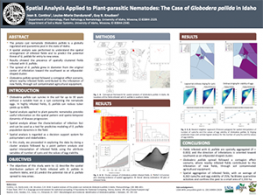
Spatial Analysis Applied to Plant-parasitic Nematodes: The Case of Globodera pallida in Idaho
A spatial analysis was performed to understand the spatial arrangement of Globodera pallida in infested fields in southern Idaho, and to predict the potential threat of G. pallida for entry into new areas.
PDF Presented at the Potato Association of America 2019 annual meeting, Boise, ID
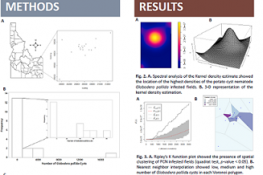
A Spatial Point Pattern Analysis of the Potato Cyst Nematode Globodera pallida in Southern Idaho
Spatial point pattern analysis used to understand the intensity and directionality of Globodera pallida (the pale cyst nematode) in fields in southern Idaho.
PDF Presented at SON Conference, August 2017
Globodera Alliance (GLOBAL): Risk assessment and eradication of Globodera spp. in U.S. production of potato.
Globodera Resistance Development
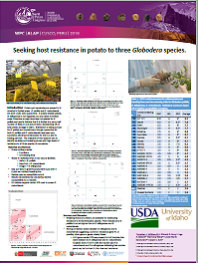
Seeking host resistance in potato to three Globodera species.
Potato cyst nematodes are present in North America in limited areas. G. pallida and G. rostochiensis are both under strict quarantine. A closely related species, G. ellingtonae is not regulated, but also exists in limited areas. Extensive surveys have been completed for G. pallida and results indicate that it is limited to a very small number of fields in one area of Idaho representing 1%of total potato acreage in Idaho. Eradication is being pursued for G. pallidaand containment through quarantine for both G. pallida and G. rostochiensis have been very successful, allowing market access for the U.S. and its trading partners. The objective of this research was to identify varieties and breeding clones with high levels of resistance to all three species of nematodes.
PDF Presented at World Potato Congress, Cusco, Peru, May 2018
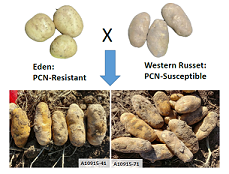
Breeding and development of Globodera-resistant potato varieties with long tuber shape and russet skin for production in the western U.S.
Two species of potato cyst nematode (Globodera rostochiensis and G. pallida) have been identified in the U.S. and are under quarantine regulations, with a third newly identified species (G. ellingtonae) not categorized as a quarantined pest. Management of G. rostochiensis in the state of New York includes the use of resistant potato varieties, but resistance to G. pallida is not present in the primary varieties grown in the state of Idaho where G. pallida was identified in 2006. The primary market class of potato grown in Idaho and the western U.S. is characterized by varieties having long tuber shape and russet skin (Fig.1). Potato varieties commercially available having G. pallida resistance typically have round tubers and white or yellow skin making them unsuitable for producers in the western U.S. Hybridizations have been conducted between Globodera-resistant breeding clones and varieties to generate PCN-resistant progenies with the long tuber type and russet skin desired for fresh-pack and fry processing in the western U.S. Sources of Globodera resistance being utilized in our program, the use of marker-assisted selection, and our progress in developing russet-skinned germ plasm having long tuber shape with resistance to the three Globodera species are described.
PDF Presented at the World Potato Conference, Cusco, Peru, May 2018.
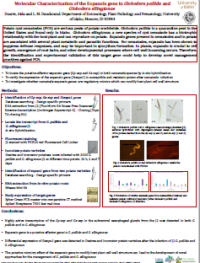
Molecular Characterization of the Expansin gene in Globodera pallida and Globodera ellingtonae
Potato cyst nematodes (PCN) are serious pests of potato worldwide. Globodera pallida is a quarantine pest in the United States and found only in Idaho. Globodera ellingtonae, a new species of cyst nematode has a biotrophic relationship with the host plant and can reproduce on potato. Expansin genes present in nematodes and in potato are associated with several plant metabolic and parasitic functions. For nematodes, expansin has been shown to suppress defense responses, and may be important in syncytium formation. In plants, expansin is crucial to cell growth, emergence of root hairs, and other developmental processes where cell wall loosening occurs. Therefore, the identification and experimental validation of this target gene could help to develop novel management practices against PCN.
PDF Presented at SON Conference, August 2017
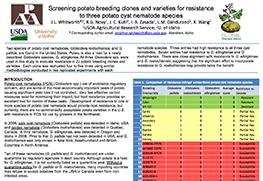
Screening potato breeding clones and varieties for resistance to three potato cyst nematode species
Two species of potato cyst nematodes, Globodera rostochiensis, and G. pallida, are found in the United States. Potato is also a host for a newly described Globodera species, G. ellingtonae. All three Globodera spp. were used in this study to evaluate resistance in 22 potato breeding clones and varieties. Each clone was replicated four to five times using similar methodologies conducted in two replicated experiments with each nematode species. Three entries had high resistance to all three cyst nematodes. Seven entries had resistance to G. ellingtonae and G. rostochiensis. There was close alignment with resistance to G. ellingtonae and G. rostochiensis, suggesting that the significant effort to incorporate resistance to G. rostochiensis may provide twice the benefit.
PDF Presented at Potato Expo, January 2017
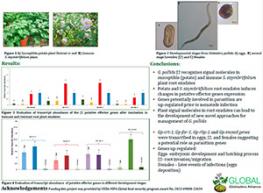
Characterization of Effector Genes from Globodera Pallida in Resistant and Susceptible Potato Plants
Potato cyst nematodes (PCN) are some of the most economically important pests of potato. Globodera pallida was first detected in the United States in Idaho in April 2006. Nematode secretions (effector genes) are the first signals perceived by the plant, and affect the host defense response, facilitates the second-stage (J2) penetration and development in the host plant.
PDF Presented at: SON/ONTA Conference, July 2016.
